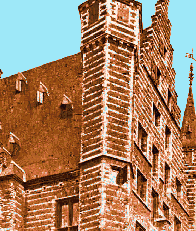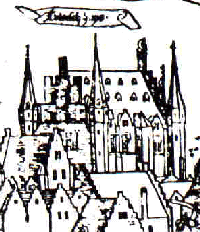BUTCHER'S HALL ('Het Vleeshuis')

 ..on an old engraving (left)
..on an old engraving (left)

..and it is still
there now (right).
A covered meat market existed in Antwerp  from the 14th century on, not far from the river, the fishmarket, the river and the old borough with its castle of the vicount, later prison, called the Steen.
from the 14th century on, not far from the river, the fishmarket, the river and the old borough with its castle of the vicount, later prison, called the Steen.

From about 1500 A.C. on, the number of inhabitants started to grow very quickly. Soon Antwerp became a very important international port and center of trade.
Old official buildings such as the Townhall, the Exchange  , the Butcher's Hall ... needed to be renewed: larger ones were necessary.
, the Butcher's Hall ... needed to be renewed: larger ones were necessary.

The first of these new, still gothic buildings was the large Butcher's Hall. In 1503 it replaced the old one in the neighbourhood of the street still called 'Vleeshouwersstraat' (Butchers' Street), where most of the butchers lived.
The animals bought on the Cattle Market not far away from here, were slaughtered in the large cellars of the Hall and also outside the building on a place still called 'Bloedberg' (Bloody Mountain) because situated on a higher level than the ditch under the building, connected to the river, through which blood and intestines disappeared ...

Meat was sold on the first floor in a very large covered market, by as many as 60 butchers, nearly 300 years long, till the end of the 18th century.
Second and third floor had many splendid rooms and saloons for festivities, meetings etc ...

The Butchers' Hall now is a CITY ARTS AND CRAFTS MUSEUM.
Have a look at: MUSEUM VLEESHUIS = external link, Flemish only.

Latest update April 7th 2005.


 ..on an old engraving (left)
..on an old engraving (left)
 from the 14th century on, not far from the river, the fishmarket, the river and the old borough with its castle of the vicount, later prison, called the Steen.
from the 14th century on, not far from the river, the fishmarket, the river and the old borough with its castle of the vicount, later prison, called the Steen.
 , the Butcher's Hall ... needed to be renewed: larger ones were necessary.
, the Butcher's Hall ... needed to be renewed: larger ones were necessary.


